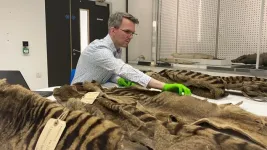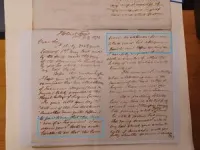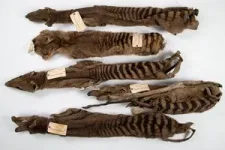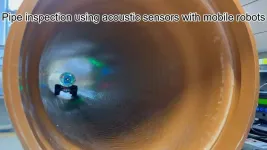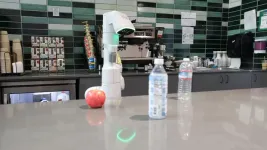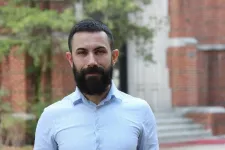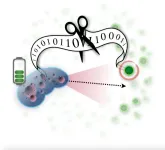(Press-News.org) A Hobart-based solicitor built his reputation as “the foremost scientist in the colony” in the mid-1800’s, despite limited contributions to scientific knowledge.
Morton Allport achieved his status by obtaining the bodily remains of Tasmanian Aboriginal people and Tasmanian tigers, also known as thylacines, and sending them to collectors in Europe – specifically asking for scientific accolades in return.
This took place in the context of a genocide against the Tasmanian Aboriginal peoples, and persecution of the thylacine that eventually led to its extinction.
The new research by Jack Ashby, Assistant Director of the University Museum of Zoology, Cambridge, is based on transcriptions of letters sent by Allport to correspondents in Australia and Europe. It is published today in the Archives of Natural History, the journal of the Society for the History of Natural History.
His research reveals how the human and environmental costs of the colonial project were entwined with practices of natural history.
Ashby spent fifteen months investigating the colonial histories of the Australian mammal collections in Cambridge and other museums. The University Museum of Zoology, Cambridge, holds one of the world’s best-preserved collections of skins of the iconic thylacine.
“Early British settlers considered both thylacines and Tasmanian Aboriginal people to be a hindrance to colonial development – and the response was institutionalised violence with the intended goal of eradicating both,” said Ashby.
In the process of reading Morton Allport’s letters, held mainly at the State Library of Tasmania, Ashby found that Allport identified himself as the principal exporter of the bodily remains of Tasmanian Aboriginal people to Europe. Allport did not send any of these remains to the University of Cambridge.
Allport shipped a total of five Tasmanian Aboriginal skeletons to Europe, proudly identifying himself as the most prolific trader in Tasmanian bodily remains. He made clear in his letters that he had directed the grave-robbing himself. The human remains sent by Allport to the United Kingdom are no longer held in British collections – they were either destroyed by bombing during the Second World War or have since been repatriated to Tasmania.
“Allport’s letters show he invested heavily in developing his scientific reputation - particularly in gaining recognition from scientific societies - by supplying human and animal remains from Tasmania in a quid pro quo arrangement, rather than through his own scientific endeavours,” said Ashby.
Ashby’s research has shown that as populations of both thylacines and Tasmanian Aboriginal people were diminished, demand for their remains in museums and private collections increased. Morton Allport worked to meet this demand.
Allport’s exploits included acquiring the remains of an Aboriginal man, William Lanne, considered a “prize specimen” as he was believed by the colonists to be the last Tasmanian man when he died in 1869. The research explains how Allport likely instructed that Lanne’s body be mutilated both before and - following his exhumation - after his burial so that Allport could add him to a museum collection in Hobart.
The events surrounding Lanne’s death have been at the centre of much debate in Tasmania in recent years, and this August it was agreed that a statue of state premier William Crowther - also implicated in the mutilation of Lanne’s body - would be removed from Hobart city centre. But until now Allport’s role has been little explored.
“Outrageously, despite state-sponsored violence committed against thylacines and Tasmanian Aboriginal peoples, they were both described by the colonists as being at fault for what happened to them – that they couldn’t cope in the ‘modern’ world,” said Ashby.
The University of Cambridge’s collection of thylacines, sent from Morton Allport in 1869 and 1871, represent the UK’s biggest collection of this species known to originate from a single person.
Thylacines were the largest marsupial carnivores of recent times. In 1830, British settlers in Tasmania established the first bounties encouraging violence against both Tasmania’s first peoples and thylacines. The last known thylacine died in 1936.
“Specimens like the thylacines in our collection hold extreme power in allowing museums to connect people to this story,” said Ashby.
He added: “Although Allport did not send any human remains to Cambridge, I can no longer look at these thylacine skins without thinking of the human story they relate to. It shows how natural history specimens aren’t just scientific data – they also reflect important moments in human history, much of which was tragically violent.”
Professor Rebecca Kilner, Head of the University’s Department of Zoology, said: “We have a remarkable collection of animals in our museum. We have long appreciated that their natural history can help us understand more about the natural world and how to conserve it. We now realise that the social history behind our collections is just as important.”
She added: “Understanding why and how animals were collected, including the underlying political and social motivations, is key to understanding and addressing some of the social inequalities that exist today."
A new web-resource sharing the stories behind the collections has been launched today. This work forms part of the University of Cambridge Museum’s inquiries into legacies of empire and enslavement.
END
Historical violence in Tasmania: Victorian collector traded human Aboriginal remains for scientific accolades, study reveals
2023-11-29
ELSE PRESS RELEASES FROM THIS DATE:
Network of robots can successfully monitor pipes using acoustic wave sensors
2023-11-29
An inspection design method and procedure by which mobile robots can inspect large pipe structures has been demonstrated with the successful inspection of multiple defects on a three-meter long steel pipe using guided acoustic wave sensors.
The University of Bristol team, led by Professor Bruce Drinkwater and Professor Anthony Croxford, developed approach was used to review a long steel pipe with multiple defects, including circular holes with different sizes, a crack-like defect and pits, through a designed inspection path to achieve 100% detection coverage for a defined reference defect.
In the study, published today in NDT and E International, ...
How do you make a robot smarter? Program it to know what it doesn’t know
2023-11-29
Modern robots know how to sense their environment and respond to language, but what they don’t know is often more important than what they do know. Teaching robots to ask for help is key to making them safer and more efficient.
Engineers at Princeton University and Google have come up with a new way to teach robots to know when they don’t know. The technique involves quantifying the fuzziness of human language and using that measurement to tell robots when to ask for further directions. Telling a robot to pick ...
Researchers working to develop next-generation polymer membranes for sustainable materials science
2023-11-28
Michele Galizia, a President’s Associates Presidential Professor in the School of Sustainable Chemical, Biological and Materials Engineering at the University of Oklahoma, is leading a research team that recently received a grant from the U.S. Department of Energy that will develop improved polymer membranes to advance molecular separation and related materials science.
“We currently separate chemicals, gases and liquids using a thermal-based distillation technology that is very expensive to operate and consumes the equivalent of eight GJ of electricity per person on the planet per year,” ...
Researchers have applied the theory of semantic information to a realistic model capturing attributes of living systems—and found the critical point where information matters for survival
2023-11-28
Living systems—unlike non-living or inanimate objects—use information about their surrounding environment to survive. But not all information from the environment is meaningful or relevant for survival. The subset of information that is meaningful, and perhaps necessary for being alive, is called semantic information.
In a new paper published in PRX Life, University of Rochester physicists and their coauthors have, for the first time, applied this theory of semantic information to a well-known ...
Growing microtumors in a dish helps rapidly identify genes that drive tumor growth
2023-11-28
Researchers have identified a new way to screen genes that cause several different types of cancers to grow, identifying particularly promising targets for precision oncology in oral and esophageal squamous cancers.
The study, published in this month’s issue of Cell Reports, used 3-dimensional models of organ tissues called organoids to identify and test potential gene targets from The Cancer Genome Atlas.
“There’s a tremendous amount of data in The Cancer Genome Atlas, ...
New research compares five retinoids for anti-photoaging therapy
2023-11-28
Over the past decades, increasing evidences have demonstrated that five retinoids, including retinol (ROL), retinol acetate (RAc), retinol propionate (RP), retinol palmitate (RPalm), and hydroxypinacolone retinoate (HPR), can be potential therapeutic agents for skin photoaging. However, therapeutic efficacies and biosafety have never been compared to these compounds. This study aimed to determine the optimal retinoid type(s) for anti-photoaging therapy both in vitro and in vivo.
The data demonstrated that four retinoids (RPalm, RP, HPR and ROL) but not RAc were effective for anti-photoaging treatment at 5 μg/mL in vitro, with action mechanisms associated with antioxidative, ...
Can health, lifestyle changes protect elders from Alzheimer's?
2023-11-28
As more medications move toward federal approval for Alzheimer’s disease, a new study led by researchers at UC San Francisco and Kaiser Permanente Washington has found that personalized health and lifestyle changes can delay or even prevent memory loss for higher-risk older adults.
The two-year study compared cognitive scores, risk factors and quality of life among 172 participants, of whom half had received personalized coaching to improve their health and lifestyle in areas believed to raise the risk of Alzheimer’s, such as uncontrolled diabetes and physical inactivity. These participants were ...
Millions of kids in U.S. have inadequate health care coverage
2023-11-28
November 28, 2023-- Inadequate health coverage is a particular problem for commercially insured children, according to a new study released by Columbia University Mailman School of Public Health. The research shows that coverage gaps are affecting publicly insured children as well. Until now, prior research had focused on documenting rates and trends in insurance consistency for children covered by all insurance types. The findings are published in JAMA Health Forum.
“While uninsurance among children has generally been declining in the U.S., our results highlight the need for a renewed focus on making sure that children’s ...
NIH awards $2.6 million to Wayne State to develop new filtration platform for insulin administration
2023-11-28
DETROIT – A Wayne State University College of Engineering professor has received a $2.65 million award from the National Institute of Diabetes and Digestive and Kidney Diseases of the National Institutes of Health to develop a novel filtration platform to improve an advanced drug delivery device to optimize diabetes insulin treatments.
Subcutaneous insulin administration (SIA) technology has improved significantly over the past two decades, but SIA technology failure and underlying tissue damage caused by insulin phenolic preservatives ...
Mayo Clinic Board of Trustees approves plans to transform healthcare, improve experience for staff and patients, redesign Rochester campus
2023-11-28
ROCHESTER, Minn. — Mayo Clinic’s Board of Trustees has approved Bold. Forward. Unbound. in Rochester, a multiyear strategic initiative that advances Mayo Clinic’s Bold. Forward. strategy to Cure, Connect and Transform healthcare for the benefit of patients everywhere. It reimagines Mayo Clinic’s downtown Rochester campus and introduces new facilities with a combination of innovative care concepts and digital technologies that will give Mayo Clinic the ability to scale transformation ...
